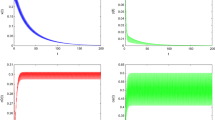Abstract
Population systems often subject to both white noise and environment pollution, so a stochastic non-autonomous omnivory Lotka–Volterra model in a polluted environment is investigated in this paper. We establish the sufficient conditions for the existence of positive periodic solution and prove it by constructing Lyapunov function. According to Itô’s formula and the strong law of large numbers for martingales, we also discuss the extinction of population. The sufficient conditions for almost sure exponential stability of equilibrium point \(E^*(0,0,0,S^*,T^*)\) are obtained. Finally, we illustrate our results by some examples with the help of computer simulation.



Similar content being viewed by others
References
Hsu, S.-B., et al.: Analysis of three species Lotka–Volterra food web models with omnivory. J. Math. Anal. Appl. 426, 659–687 (2015)
Namba, T., et al.: Omnivory and stability of food webs. Ecol. Complex. 5, 73–85 (2008)
Krikorian, N.: The Volterra model for three species predator-prey systems: boundedness and stability. J. Math. Biol. 7, 117–132 (1979)
Kratina, P., et al.: Stability and persistence of food webs with omnivory: is there a general pattern? Ecosphere 3(6), 794–804 (2012)
Zhou, S.R., et al.: Persistence and global stability of positive periodic solutions of three species food chains with omnivory. J. Math. Anal. Appl. 324, 397–408 (2006)
Ma, H.P., et al.: Global stability of positive periodic solutions and almost periodic solutions for a discrete competitive system. Discr. Dyn. Nat. Soc. 2015, 1–13 (2015)
Doubova, A., et al.: Extinction-time for stochastic population models. J. Comput. Appl. Math. 295, 159–169 (2016)
Khasminskii, R.: Stochastic Stability of Differential Equations, 2nd edn. Springer, Berlin (2012)
Li, X., et al.: Population dynamical behavior of Lotka–Volterra system under regime switching. J. Comput. Appl. Math. 232, 427–448 (2009)
Liu, M., et al.: Asymptotic properties and simulations of a stochastic logistic model under regime switching. Math. Comput. Model. 54, 2139–2154 (2011)
Cheng, S.R.: Stochastic population systems. Stoch. Anal. Appl. 27, 854–874 (2009)
Wu, R., et al.: Asymptotic behavior of a stochastic non-autonomous predator-prey model with impulsive perturbations. Commun. Nonlinear Sci. Numer. Simul. 20, 965–974 (2015)
Liu, M., et al.: On a stochastic logistic equation with impulsive perturbations. Comput. Math. Appl. 63, 871–886 (2012)
Hallam, T.G., et al.: Effects of toxicants on population: a qualitative approach I. Equilibrium environmental exposure. Ecol. Model. 8, 291–304 (1983)
Dubey, B., et al.: Modelling effects of industrialization, population and pollution on a renewable resource. Nonlinear Anal. Real World Appl. 11, 2833–2848 (2010)
Luo, Z., et al.: Optimal control for an age-dependent competitive species model in a polluted environment. Appl. Math. Comput. 228, 91–101 (2014)
Liu, M., et al.: Survival analysis of stochastic competitive models in a polluted environment and stochastic competitive exclusion principle. Bull. Math. Biol. 73, 1969–2012 (2011)
Xie, X.L., et al.: Almost periodic sequence solution of a discrete Hassell–Varley predator-prey system with feedback control. Appl. Math. Comput. 268, 35–51 (2015)
Zhong, L., et al.: Almost periodic solutions of a discrete almost periodic logistic equation with delay. Appl. Math. Comput. 232, 743–751 (2014)
Zu, L., et al.: Periodic solution for a non-autonomous Lotka–Volterra predator-prey model with random perturbation. J. Math. Anal. Appl. 430, 428–437 (2015)
Zuo, W.J., et al.: Stationary distribution and periodic solution for stochastic predator-prey systems with nonlinear predator harvesting. Commun. Nonlinear Sci. Numer. Simul. 36, 65–80 (2016)
Mao, X.: Stochastic Differential Equations and Applications, 2nd edn. Horwood Publishing, Chichester (2007)
Liu, M., et al.: Persistence, extinction and global asymptotical stability of a non-autonomous predator-prey model with random perturbation. Appl. Math. Model. 36, 5344–5353 (2012)
Acknowledgements
The research is supported by the National Natural Science Foundation of China (Nos. 11261043, 11461053, and 11661064) and Innovation Project of Ningxia University (GIP201624). The authors would like to thank the editors and anonymous reviewers for their valuable comments which improve the presentation of this paper.
Author information
Authors and Affiliations
Corresponding author
Rights and permissions
About this article
Cite this article
Cao, B., Li, X., Li, Q. et al. The Analysis of Stochastic Lotka–Volterra Model in Polluted Environment. Differ Equ Dyn Syst 26, 199–212 (2018). https://doi.org/10.1007/s12591-016-0334-6
Published:
Issue Date:
DOI: https://doi.org/10.1007/s12591-016-0334-6




